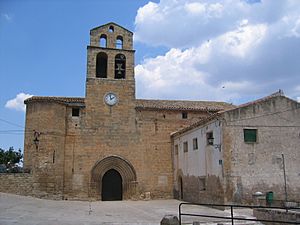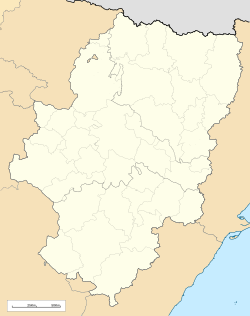Arens de Lledó facts for kids
Quick facts for kids
Arens de Lledó/Arenys de Lledó
|
|
|---|---|
 |
|
| Country | Spain |
| Autonomous community | Aragon |
| Province | Teruel |
| Municipality | Arens de Lledó/ Arenys de Lledó |
| Area | |
| • Total | 34.27 km2 (13.23 sq mi) |
| Population
(2018)
|
|
| • Total | 206 |
| • Density | 6.011/km2 (15.57/sq mi) |
| Time zone | UTC+1 (CET) |
| • Summer (DST) | UTC+2 (CEST) |
Arens de Lledó (also called Arenys de Lledó) is a small town in Spain. It is located in the province of Teruel, which is part of the Aragon region. This town is in an area known as Matarraña/Matarranya.
In 2018, about 206 people lived here. The town covers an area of about 34 square kilometers. It is also part of a special area called the Franja de Ponent.
Contents
Discover Arens de Lledó
Arens de Lledó is close to some interesting places. One neighbor is Horta de San Juan in Catalonia. This area is famous for the El Ports Natural Park. Some people even say that the artist Picasso developed his Cubism style after staying there.
Another nearby town is Calaceite, which is the cultural center of Matarraña. Many artists from around the world enjoy visiting Calaceite.
The village of Arens de Lledó is in the eastern part of the Teruel province. It is in a hilly area next to the Algars River. This river forms the border between Terra Alta (in Catalonia) and Aragon. The Algars River has a popular swimming spot called "El Galero" where locals and visitors like to cool off.
Overlooking the village is the Church of the Assumption of the Virgin Mary. This church was built in the 15th and 16th centuries in a Gothic style. It has an old archway from the Middle Ages. Inside, you can see a special sculpture of two fish, which is a symbol for the village. On February 8, 1983, the church was recognized as an important "object of cultural interest."
A Look Back: History of Arens de Lledó
Arens de Lledó has a long history, with signs of people living there for many centuries.
Ancient Times: Bronze and Iberian Periods
The first people settled in this area during the Bronze Age and the Iberian Period. This shows that humans have lived here for a very long time.
The Islamic Era
During the time of Islamic rule, people built an "Azud" here. An Azud is an Arabic word for a barrier used to direct river water into canals. This helped with farming and water supply.
The Middle Ages
You can still find parts of the old city wall from the Middle Ages. About 6 kilometers away, at the chapel of St. Hippolytus (Sant Pol), you can see the base of a medieval column. A cross from the Knights Templar can also be found there.
This holy place is now a spot for pilgrimages. Every year on the first Saturday in May, a procession takes place. It is a tradition that women would visit this place to ask for fertility. The path to the chapel is lined with old cypress trees.
Recent History
The Spanish Civil War (from 1936 to 1939) also affected this village. In the nearby town of Gandesa (in Catalonia), there is a museum about the Battle of the Ebro, a very important battle from that war.
After the war, there was a lot of trouble and very cold weather. This made farming difficult. Because of this, many people moved to cities like Barcelona and Valencia to find new jobs and opportunities.
What People Do: Economy
Most people in Arens de Lledó work in agriculture. They grow olives, almonds, and grapes. There is also a special group called an agricultural cooperative that helps farmers. Some people also work in rural tourism, welcoming visitors to the area.
See Also
 In Spanish: Arens de Lledó para niños
In Spanish: Arens de Lledó para niños



